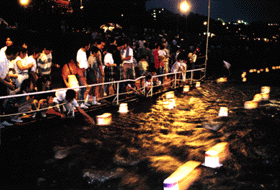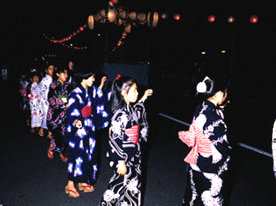ANNUAL CALENDAR August |
|
Bon holidays
|
 The Bon Festival is held to pray for the repose of the souls of one's ancestors. It's one of the biggest traditional events during the year, along with New Year's. It's sometimes called o-bon or urabon. In the past, it was held in the middle of the seventh month on Japan's traditional calendar.
The Bon Festival is held to pray for the repose of the souls of one's ancestors. It's one of the biggest traditional events during the year, along with New Year's. It's sometimes called o-bon or urabon. In the past, it was held in the middle of the seventh month on Japan's traditional calendar.
Some regions therefore celebrate it in mid-July, although the old date is closer to mid-August. Deceased family members are believed to revisit the homestead during Bon to be reunited with their family. To guide the souls back, a small bonfire is lit outside the house. This is called the mukae-bi, or welcoming flame. The house is cleaned and dusted, and fruits and vegetables are offered at family altars. When Bon ends, the spirits are sent off with another bonfire, called okuri-bi. Some regions release small lanterns down rivers or into the sea as part of the okuri-bi ritual. Many Buddhist temples hold a service called urabon'e during this time, and so a lot of people think Bon is a Buddhist tradition. But historians now think that indigenous Japanese practices combined with Buddhist concepts to give shape to the Bon customs observed today.  The biggest event of the Bon season is the Bon odori (dance), which is held throughout Japan. One of the most famous is the Awa odori of Tokushima. People usually go to the neighborhood park or shrine in yukata (summer kimono) and dance in a circle to recorded music.
The biggest event of the Bon season is the Bon odori (dance), which is held throughout Japan. One of the most famous is the Awa odori of Tokushima. People usually go to the neighborhood park or shrine in yukata (summer kimono) and dance in a circle to recorded music.
Mid-August comes during summer vacation for elementary and middle school students. A lot of companies, too, now offer their workers time off by closing their factories and offices during Bon. Urban residents take advantage of the holidays to return to their hometowns and participate in Bon events. For the kids, the Bon break is a chance to visit their grandparents and meet other relatives. The beginning and end of the Bon holidays are marked long traffic jams of people leaving and returning to their urban residences. Airports and major train stations become jam packed with travelers, and expressways leading in and out of big cities get clogged up for 30 kilometers (18.5 miles) or more. Shinkansen (bullet trains) and other long-distance trains often run at 180% of capacity.
Photos: (Top) People send lanterns down rivers to "see off" the spirits of their relatives; (above) everyone looks forward to Bon odori in summertime. (Tokyo Metropolitan Government) |
APR | MAY | JUN | JUL | AUG | SEP | OCT | NOV | DEC | JAN | FEB | MAR |
 |